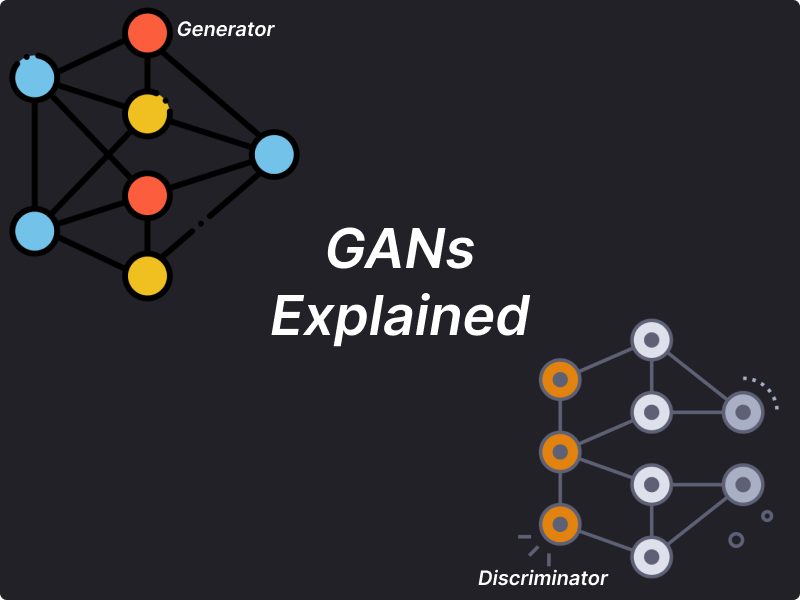What are GANs?
Generative Adversarial Networks (GANs) are artificial intelligence algorithms used in unsupervised machine learning. Introduced by Ian Goodfellow and his colleagues in 2014, they consist of two neural networks: the generator and the discriminator. The generator's task is to produce new data samples, whereas the discriminator aims to differentiate real data from the data created by the generator.
How do GANs work?
-
Generator: This network inputs random noise and generates data samples. Its goal is to produce data similar to the real data that the discriminator cannot differentiate.
-
Discriminator: This network takes real and fake data (generated by the generator) as input and tries to distinguish between them. The aim is to accurately distinguish between genuine and generated data.
During training, the generator tries to improve its ability to generate realistic data to fool the discriminator, while the discriminator tries to improve its ability to distinguish between real and fake data. This results in a kind of "game" between the two networks, which is why it's called "adversarial."
The generator and discriminator are both trained at the same time through the following process:
-
Generator Training: The generator creates a batch of fake data.
-
Discriminator Training: The discriminator is trained to distinguish between real and fake data.
-
Adversarial Training: The generator is then updated to produce better fake data that can fool the discriminator.
-
Iteration: These steps are repeated many times, with both networks improving their performance until the fake data is nearly indistinguishable from the real data.
The goal is for the generator to become so good at creating realistic data that the discriminator can't reliably tell the difference.
Applications of GANs:
-
Image Generation: GANs can be used to generate realistic images, which have applications in creating artwork, generating synthetic data for training other models, and even in video game development.
-
Data Augmentation: GANs can augment datasets by generating additional realistic data samples, which can help improve the performance of machine learning models.
-
Style Transfer: GANs can be used to transfer the style of one image onto another, creating visually appealing effects.
-
Image-to-Image Translation: GANs can translate images from one domain to another, such as turning sketches into realistic images, converting satellite images to maps, or turning day scenes into night scenes.
-
Text-to-Image Synthesis: Generating images based on textual descriptions.
Types of GANs:
There are several variants of GANs, each designed to address specific challenges or extend the capabilities of the original GAN framework.
-
DCGAN (Deep Convolutional GAN): This type of GAN uses deep convolutional networks in both the generator and the discriminator, which enables it to generate high-quality images.
-
Conditional GAN: In a conditional GAN, the generator and discriminator are conditioned on additional information, such as class labels or attributes. This allows for a more controlled generation of data.
-
Cycle GAN: Cycle GANs are used for image-to-image translation tasks where there are paired examples in the training data but no direct correspondence between the domains. It learns to translate images from one domain to another and back again while preserving important characteristics.
-
Wasserstein GAN (WGAN): WGANs use a different loss function called the Wasserstein distance, which provides a more stable training process and produces higher-quality samples.
-
Paired Image-to-Image Translation: In this type of GAN, there are paired examples in the training data, meaning each input image has a corresponding output image. This allows the model to learn a direct mapping between the input and output domains.
-
Unpaired Image-to-Image Translation: Unlike paired image-to-image translation, unpaired translation GANs learn to translate images from one domain to another without directly paired examples. They rely on learning the underlying characteristics of each domain and finding correspondences between them.

Generative Adversarial Networks and Deep Learning 1st Edition
This book delves into the use of generative adversarial networks in various applications and highlights their significant advancements over traditional generative models.
Conclusion
Generative Adversarial Networks (GANs) are a powerful framework for generating realistic data through the adversarial training of two neural networks. Variants of GANs, such as DCGAN, cGAN, CycleGAN, WGAN, and others, extend the capabilities of the original GAN framework to handle different types of data and applications.
Each type of GAN has its strengths and weaknesses, and the choice of which to use depends on the specific task and dataset. But they all share the common goal of generating realistic data samples, pushing the boundaries of what AI can create.
If you found this article helpful consider subscribing to Ibepyprogrammer and sharing.
Thank you.




